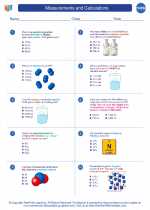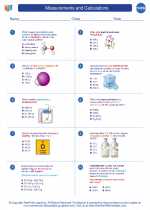Boyle's Law
Boyle's Law is one of the fundamental gas laws in chemistry, which describes the relationship between the pressure and volume of a gas at constant temperature. The law is named after the Irish scientist Robert Boyle, who first stated it in 1662.The Law
Boyle's Law can be expressed mathematically as:
P₁V₁ = P₂V₂
Where P₁ and V₁ are the initial pressure and volume, and P₂ and V₂ are the final pressure and volume of a gas sample at constant temperature.
Explanation
Boyle's Law states that the pressure of a given amount of gas is inversely proportional to its volume, when the temperature is held constant. In other words, if the volume of a gas decreases, its pressure increases, and vice versa.
Study Guide
To understand and apply Boyle's Law, consider the following key points:
- Constant Temperature: Boyle's Law is only applicable when the temperature remains constant.
- Inversely Proportional: Remember that pressure and volume are inversely proportional to each other according to Boyle's Law.
- Mathematical Application: Practice using the mathematical formula P₁V₁ = P₂V₂ to solve problems related to changes in pressure and volume of a gas.
- Real-life Applications: Understand how Boyle's Law is relevant in various real-life scenarios, such as scuba diving, where changes in pressure and volume affect the behavior of gases.
By mastering Boyle's Law, you'll be able to comprehend the behavior of gases and make accurate predictions about their pressure-volume relationships in different conditions.
[Boyle's Law] Related Worksheets and Study Guides:
.◂Chemistry Worksheets and Study Guides High School. Measurements and Calculations
Worksheet/Answer key Measurements and Calculations
Measurements and Calculations  Worksheet/Answer key
Worksheet/Answer key Measurements and Calculations
Measurements and Calculations  Worksheet/Answer key
Worksheet/Answer key Measurements and Calculations
Measurements and Calculations 

 Worksheet/Answer key
Worksheet/Answer key
 Worksheet/Answer key
Worksheet/Answer key

The resources above cover the following skills:
CHEMISTRY
Matter and Its Interactions
Use the periodic table as a systematic representation to predict properties of elements based on their valence electron arrangement.
Use the periodic table as a model to derive formulas and names of ionic and covalent compounds.
Reading Standards for Literacy in Science and Technical Subjects
Craft and Structure
Determine the meaning of symbols, key terms, and other domain-specific words and phrases as they are used in a specific scientific or technical context relevant to Grades 9-10 texts and topics.
Reading Standards for Literacy in Science and Technical Subjects
Craft and Structure
Determine the meaning of symbols, key terms, and other domain-specific words and phrases as they are used in a specific scientific or technical context relevant to Grades 11-12 texts and topics.